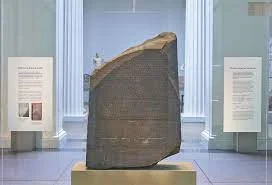Blog Tour: Secrets of the Dead and The Curse of the Tomb Robbers
I am delighted to be taking part in this Blog Tour. Both of these books are published in collaboration with the British Museum, one of my favourite places to visit and somewhere I have spent many happy hours!
It is home to the Rosetta Stone, a large stelle inscribed with three translations of a single passage, written in two Egyptian language scripts (hieroglyphic and Demotic) and in classical Greek. Named after the town on the Mediterranean coast in Egypt in which it was found, the Rosetta Sone was deciphered largely through the efforts of Thomas Young of England and Jean-François Champollion of France. Champollion made a crucial step in understanding ancient Egyptian writing when he identified the hieroglyphs that were used to write names, deciphering ‘Ptolemy’ and ‘Cleopatra’. He finally announced his discovery on the 27th September, 1822- two hundred years ago today which makes it the perfect day for reviewing these two book!
In ‘The Curse of the Tomb Robbers’, Andy Seed mixes story with problem solving to engage children with learning more about life in Ancient Egypt. Nub and his friend, Iteti, are introduced to the reader at the beginning of the book, along with information on how to use the codebreaker. Full of details of life at this time, the story is not only engaging, but a mine of information about this period of Egyptian history.
The puzzles encourage children to use hieroglyphs, learning in which direction they should be read, how to identify royal names and how to use the number system. Other puzzles are also included and all the solutions are given at the end of the story with explanation when necessary.
The illustrations are wonderful. Sure to instigate conversation about Egyptian life and offering plenty of opportunity for children to practise identifying hieroglyphs, they would be perfect for using as starting points for children to develop their own stories about Nub and Iteti, other figures shown in the pictures or characters of their own invention. Whether being used in class or at home, ‘The Curse of the Tomb Robbers’ is a welcome addition for those interested in or learning about the Egyptians.
‘Secrets of the Dead’ looks at human remains from around the world. Starting in Africa, the book focuses on Egypt and the mummification processes the Ancient Egyptians used to preserve their dead. Starting with the formal burials of Tutankhamun and Rameses the Great, the book also looks at the natural mummification of Gebelein Man and explores what can be learned in each case. Having taught the Egyptians many times, I can vouch for the fact that this is an area which fascinates children and the text is both accessible and interesting.
The book then continues with examples from the other continents showing how the dead have been preserved, offering specific examples such as the Ice Maiden of the Altai mountains and the bodies displayed in the Capuchin Catacombs beneath Palermo in Sicily (somewhere I did not visit when there!)
The book concludes with drawing attention to the amazing secrets of the past which have been uncovered by studying the bodies of those from the past as well as all the things that remain unknown. A map of the world shows the location of each discovery and a comprehensive glossary helps to explain many of the terms used. The History curriculum at KS2 says that pupils should learn about ‘the achievements of the earliest civilizations – an overview of where and when the first civilizations appeared and a depth study of one of the following: Ancient Sumer; The Indus Valley; Ancient Egypt; The Shang Dynasty of Ancient China’. ‘Secrets of the Dead’ allows for comparisons to be made between death customs and discoveries in various locations around the world, encouraging children to make comparisons between different civilisations.
The Curse of the Tomb Robbers
Andy Seed, illustrated by James Weston Lewis
Nosy Crow ISBN: 978-1788009652
Secrets of the Dead
Matt Ralphs, illustrated by Gordy Wright
Nosy Crow ISBN: 978-1788009003
Two excellent books to support the history curriculum or to develop a passion for the past! Many thanks to Catherine Ward for inviting me to take part in this Blog Tour.
Make sure you look at the next posts!







